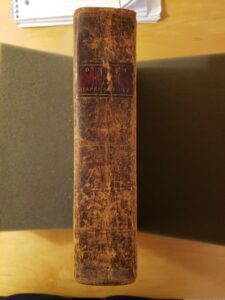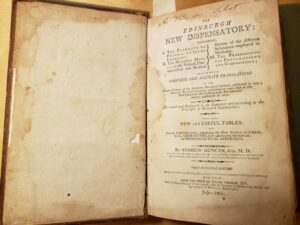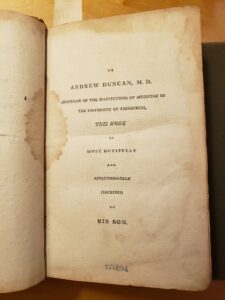The authorship of the Edinburgh New Dispensatory’s spans nearly a century. At first glance of the physical book, this would likely start with determining the identity of the “Duncan” described on the spine (Figure 1) Though the 1805 version’s title page lists Andrew Duncan Jr. as its author, further research reveals the multifaceted authorship of the book and positions Duncan Jr. as an editor and compiler of multiple works (Figure 2). As the name implies, the Dispensatory’s content originates in Edinburgh, and so the main contributors of William Lewis, Andrew Duncan Sr., and Andrew Duncan Jr. all hail from the city. More importantly, for the Dispensatory to earn the “new” title, there must be an original “old” dispensatory, in which William Lewis was the originator. Lewis worked as physician and chemist in his lifetime of 1708 to 1781. Though the Oxford Dictionary of National Biography does not say from which language, it does note that his translation of the 4th edition of the Edinburgh Pharmacopoeia in 1748 also appears in the New Dispensatory (Page “Lewis”). Among many other publications, he edited and reworked John Quincy’s Compleat English Dispensatory into what would be the first 1753 edition of The New Dispensatory (Page “Lewis”). Quincy’s English Dispensatory also has a long lineage of success; the book was on published in its 12th edition in 1749 before the New Dispensatory’s publication (“Compleat English”).

Figure 1-The spine of the dispensatory- who does “Duncan” refer to?

Figure 2- Title Page
Thus, the publication of the Dispensatory represents another step in a long line of medical and familial history. According to the Cambridge Dictionary of Scientists, the end of the 18th century coincided with a rise in consolidating the meaning of “’clinical’ medicine” and moving towards diagnosis based on senses rather than humors (Cunningham, “History”). The city of Edinburgh also represented another step in printing evolution. Over 14,000 imprints were published across the second half of the 17th century in Edinburgh, making it the 3rd largest publishing city overall in the anglophone book production sphere (Sher 34). Thus, even if we cannot pin the specific numbers for the Dispensatory’s printing, we can at least know the cultural and historical moments surrounding its production. Despite being the physically edited work of Andrew Duncan Sr., his father seemed to have contributed as much in spirit, if not specific words. This is acknowledged by the dedication page, as well (Figure 3). Duncan Sr. was a physician and professor for the University of Edinburgh, eventually writing several medical journals, one of which was apparently discontinued to make room for his son’s similar medical publication (Bettany “Elder”). Out of twelve children, only Duncan Jr. followed the path of the father in medicine (Bettany “Duncan”) After gaining experience working with his father in Annals of Medicine, Duncan Jr. published the first edition of the Edinburgh New Dispensatory in 1803 (Bettany “Duncan”). As the ODNB website notes, the Dispensatory gained renown enough to be published in French and German, as well as in the United States (Bettany “Duncan”). Thus, the Worcester Press edition published in 1805 can be surmised to be part of this publication expansion in the United States.

Figure 3- Dedication Page
The publication transition to American from Edinburgh also reflects a similar patrilineal dynamic as seen with the Duncans. In the title page, the 1805 edition states its origins in uppercase from the “press of Isaiah Thomas Jr” (Figure 2). Though stated as a “first Worcester edition,” the type below the press section also notes in lowercase that the book was sold to him by “Thomas and Andrews, Boston, and Thomas and Whipple, Newburyport” (Figure 1). After further research, Isaiah Thomas Jr. followed in his father’s footsteps, identical to the Duncans. Like Andrew Duncan Jr., much more information exists on their fathers instead of them themselves. When looking at the full life story of Isaiah Thomas Sr., the reasons why become clear.
Through his printing press powers, Thomas helped incite the Revolutionary War. In 1770, Thomas started publication of the Massachusetts Spy which was known for continual criticism of the government and favor towards revolution (Hixson “Thomas”). In 1773 he opened a printing house in Newbury Port where he also continued to publish a variety of works that were not specifically political (Hixson “Thomas”). However, the British takeover of Boston forced him to relocate once more to a location in Worcester in 1775, thus almost certainly being the place where the 1805 Dispensatory was published (Hixson “Thomas”). After the war and establishment of printing locations beyond Massachusetts, Thomas published and invested in over 400 titles in his printing houses, some of which included works by Rosseau, Paine, Noah Webster, and the oldest American edition of Mother Goose (Hixson “Thomas”). In short, Isaiah Thomas’ prolific printing acumen had impressive contributions to both the printing field and the development of United States as a nation. However, everything must end, and for Isaiah Thomas Sr.’s working life, this was his retirement at the start of the 19th century (Hixson “Thomas”). Starting in 1800, he started to transfer ownership of his printing businesses over to Isaiah Thomas Jr. (Knoles “Isaiah”). Thus, the Dispensatory’s publication situates itself in multiple scientific, political, and personally significant historical events.
Evidence of the Dispensatory’s success and legacy can still be seen today from the copies of this over two-hundred-year-old book still in existence. When examining the World Cat site, the Dispensatory has at least 69 copies in the United States in various editions (“Dispensatory”). The WorldCat does not have the Dickinson edition registered, which also implies there may be many yet still unregistered. Appropriately, they are mainly housed in college medical libraries, such as the Yale, Holy Cross, and Harvard medical libraries. The Dispensatory also appears in preservation organizations like the Connecticut Historical Society in Hartford. These copies mainly are housed along the East Coast United States with a specific concentration in the Northeast, though copies cover as far as California and Texas. The farthest copy from Carlisle, Pennsylvania rests in Wellcome Library in London, though another edition (“Dispensatory”). The 1805 edition appears in 44 libraries according to Worldcat, also indicating popularity. Despite being published in Worcester, at least one 1805 edition traveled as far as the Canadian city of Alberta (“Dispensatory”). To have journeyed so far from the original publication in Boston signals this book to have at least moderate success and import. The fact the there are many editions also implies a demand to keep printing and updating, further insinuating at least moderate success. Overall, the Edinburgh New Dispensatory has a sizable material, political, and culture success as evidenced by the surviving copies and historical legacies and associations gone into creation.
Works Cited:
Bettany, G.T. “Duncan, Andrew (1773–1832), physician and expert in forensic science.” Oxford Dictionary of National Biography, 23 September 2004, https://www-oxforddnb- com.dickinson.idm.oclc.org/display/10.1093/ref:odnb/9780198614128.001.0001/odnb- 9780198614128-e-8213?rskey=aqJK4e&result=3. Accessed 4 March 2023.
Bettany, G.T. “Duncan, Andrew, the elder (1744–1828), physician.” Oxford Dictionary of National Biography, 11 August 2022, https://www-oxforddnb-com.dickinson.idm.oclc.org/display/10.1093/ref:odnb/9780198614128.001.0001/odnb- 9780198614128-e-8212?rskey=ZYJaVh&result=2. Accessed 4 March 2023.
Cunningham, Andrew. “The History of Medicine.” The Cambridge Dictionary of Scientists, edited by David Millar, Cambridge University Press, 2nd edition, 2002. Credo Reference, https://dickinson.idm.oclc.org/login?url=https://search.credoreference.com/content/entry/ dicscientist/the_history_of_medicine/0?institutionId=2613. Accessed 10 Apr. 2023.
Hixson, Richard F. “Thomas, Isaiah.” American National Biography, February 2000, https://www-anb- org.dickinson.idm.oclc.org/display/10.1093/anb/9780198606697.001.0001/anb-9780198606697-e-1601625?rskey=oSGAKW&result=2. Accessed 4 March 2023.
Knoles, Thomas. “Thomas, Isaiah (1749 1831).” The Bloomsbury Encyclopedia of the American Enlightenment, edited by Mark Spencer, Bloomsbury, 1st edition, 2014. Credo Reference, https://dickinson.idm.oclc.org/login?url=https://search.credoreference.com/content/entry/bloome/thomas_isaiah_1749_1831/0?institutionId=2613. Accessed 08 April 2023.
Page, Frederick G. “Lewis, William.” Oxford Dictionary of National Biography, 30 May 2013, https://www.oxforddnb.com/display/10.1093/ref:odnb/9780198614128.001.0001/odnb-9780198614128-e-16609?rskey=QvYr86&result=4#odnb-9780198614128-e-16609- div1-d790392e383. Accessed 4 March 2023.
“Pharmacopœia officinalis & extemporanea: or, a compleat English dispensatory, in two parts, theoretic and practical. Part I. In two books. Book I. Of the Definition, Subject, General Intentions, Media, Instruments, and Operations of Pharmacy. Book II. Of the Distribution into proper Classes, General Nature, and Medicinal Virtues, &c. of Simples. Part II. In five books. Book I. Of the Preparation of Simples. Book II. Of Saline Preparations. Book III. Of Metalline Preparations. Book. IV. Of Officinal Compositions; containing all the Prescriptions of the London and Edinburgh Pharmacopoeias, according to the last Alterations thereof ; together with those of other Authors, and the present Practice, which claim any Notice. Book V. Of Extemporaneous Prescriptions; which are therein disposed into proper Classes according to their several Curative Intentions. By John Quincy, M.D.” World Cat, https://www.worldcat.org/title/642351600. Accessed 4 March 2023.
“The Edinburgh new dispensatory: containing, I. The elements of pharmaceutical chemistry. II. The materia medica … III. The pharmaceutical preparations and compositions; including complete and accurate translations of the octavo edition of the London pharmacopoeia, published in 1791; Dublin pharmacopoeia, published in 1794; and of the new edition of the Edinburgh pharmacopoeia, published in 1803. Illustrated and explained in the language and according to the principles of modern chemistry. With many new and useful tables. And several copperplates, explaining the new system of chemical characters, and representing the most useful pharmaceutical apparatus.” WorldCat, https://www.worldcat.org/title/5158379. Accessed 4 March 2023.
Sher, Richard B. “Corporatism and Consensus in the Late Eighteenth-Century Book Trade: The Edinburgh Booksellers’ Society in Comparative Perspective.” Book History, vol. 1, 1998, pp. 32–93. JSTOR, http://www.jstor.org/stable/30227282. Accessed 11 Apr. 2023.
Leave a Reply